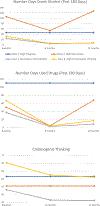Substance use and criminogenic thinking: Longitudinal latent class analysis of veterans with criminal histories
- PMID: 36215912
- PMCID: PMC9940453
- DOI: 10.1016/j.jsat.2022.108893
Substance use and criminogenic thinking: Longitudinal latent class analysis of veterans with criminal histories
Abstract
Introduction: The objective of this study was to inform clinical practice by identifying distinct subgroups of US veterans with criminal histories in residential mental health treatment. The study characterized veteran patients on their alcohol and drug use and criminogenic thinking. We also examined predictors and outcomes of subgroup membership.
Methods: Participants were 341 veterans with a criminal history in residential mental health care. A parallel latent growth trajectory model characterized participants' alcohol and drug use and criminogenic thinking at treatment entry and at 6- and 12-month follow-ups.
Results: The study identified four distinct classes: 53 % Normative Improvement, 27 % High Criminogenic Thinking, 11 % High Recurrence (of substance use), and 9 % High Drug Use. Compared to the Normative Improvement class, prior to treatment entry, patients in the High Recurrence class were less likely to be on parole or probation, and patients in the High Criminogenic Thinking class were more likely to be chronically homeless. Compared to the Normative Improvement class, at follow-ups, patients in the High Drug Use and High Criminogenic Thinking classes were more likely to recidivate, and patients in the High Drug Use class were more likely to report unstable housing. Depression scores were higher (nearly double) in the High Drug Use, High Recurrence, and High Criminogenic Thinking classes at follow-ups compared to the Normative Improvement class.
Conclusions: That the Normative Improvement class entered mental health residential treatment with relatively low alcohol and drug use and criminogenic thinking, and sustained these low levels, suggests that treatment does not need to be broadened or intensified to improve these domains for these patients with criminal histories. In contrast, findings for the High Drug Use, High Recurrence, and High Criminogenic Thinking classes, which composed 47 % of the sample, suggest that more integrated and sustained treatment may be needed to reduce recidivism, depression, and homelessness among these patients.
Trial registration: ClinicalTrials.gov NCT02524171.
Keywords: Alcohol use; Criminogenic thinking; Drug use; Treatment outcomes; Veterans.
Published by Elsevier Inc.
Figures
Similar articles
-
Intervention for Justice-Involved Homeless Veterans With Co-Occurring Substance Use and Mental Health Disorders: Protocol for a Randomized Controlled Hybrid Effectiveness-Implementation Trial.JMIR Res Protoc. 2025 Jul 18;14:e70750. doi: 10.2196/70750. JMIR Res Protoc. 2025. PMID: 40680272 Free PMC article.
-
Psychological therapies for post-traumatic stress disorder and comorbid substance use disorder.Cochrane Database Syst Rev. 2016 Apr 4;4(4):CD010204. doi: 10.1002/14651858.CD010204.pub2. Cochrane Database Syst Rev. 2016. PMID: 27040448 Free PMC article.
-
Pharmacological interventions for drug-using offenders.Cochrane Database Syst Rev. 2015 Jun 2;2015(6):CD010862. doi: 10.1002/14651858.CD010862.pub2. Cochrane Database Syst Rev. 2015. PMID: 26035084 Free PMC article.
-
Pharmacological interventions for drug-using offenders.Cochrane Database Syst Rev. 2013 Dec 19;(12):CD010862. doi: 10.1002/14651858.CD010862. Cochrane Database Syst Rev. 2013. Update in: Cochrane Database Syst Rev. 2015 Jun 02;(6):CD010862. doi: 10.1002/14651858.CD010862.pub2. PMID: 24353217 Updated.
-
Sex differences in the impact of social determinants of health on substance use disorder treatment outcomes.Biol Sex Differ. 2025 Jul 22;16(1):56. doi: 10.1186/s13293-025-00734-3. Biol Sex Differ. 2025. PMID: 40696464 Free PMC article.
Cited by
-
Disentangling the relationship between posttraumatic stress disorder, criminogenic risk, and criminal history among veterans.Law Hum Behav. 2023 Oct;47(5):579-590. doi: 10.1037/lhb0000542. Law Hum Behav. 2023. PMID: 37816136 Free PMC article.
-
Is the Risk of Alzheimer's Disease and Related Dementias Among U.S. Veterans Influenced by the Intersectionality of Housing Status, HIV/AIDS, Hepatitis C, and Psychiatric Disorders?J Gerontol A Biol Sci Med Sci. 2024 Aug 1;79(8):glae153. doi: 10.1093/gerona/glae153. J Gerontol A Biol Sci Med Sci. 2024. PMID: 38869510 Free PMC article.
-
Scoping review of military veterans involved in the criminal legal system and their health and healthcare: 5-year update and map to the Veterans-Sequential Intercept Model.Health Justice. 2024 Apr 19;12(1):18. doi: 10.1186/s40352-024-00274-9. Health Justice. 2024. PMID: 38639813 Free PMC article.
References
-
- Asparouhov T, & Muthén B (2014). Auxiliary variables in mixture modeling: Using the BCH method in Mplus to estimate a distal outcome model and an arbitrary secondary model. Mplus Web Note #21. Retrieved from https://www.statmodel.com/download/asparouhov_muthen_2014.pdf.
-
- Asparouhov T, & Muthén BO (2014). Auxiliary variables in mixture modeling: A 3-step approach using Mplus. Structural Equation Modeling: A Multidisciplinary Journal, 21(3), 329–341. 10.1080/10705511.2014.915181 - DOI
-
- Blonigen DM, Cucciare MA, Timko C, Smith JS, Harnish A, Kemp L, Rosenthal J, & Smelson D (2018). Study protocol: A hybrid effectiveness-implementation trial of moral reconation therapy in the US veterans health administration. BMC Health Services Research, 18, 164. 10.1186/s12913-018-2967-3 - DOI - PMC - PubMed



